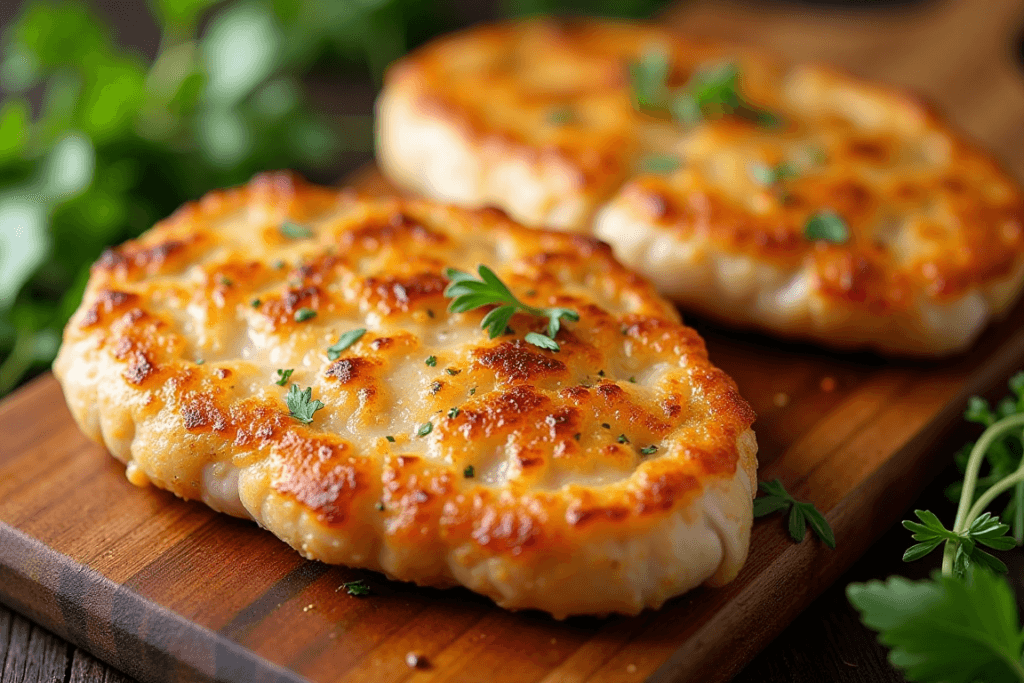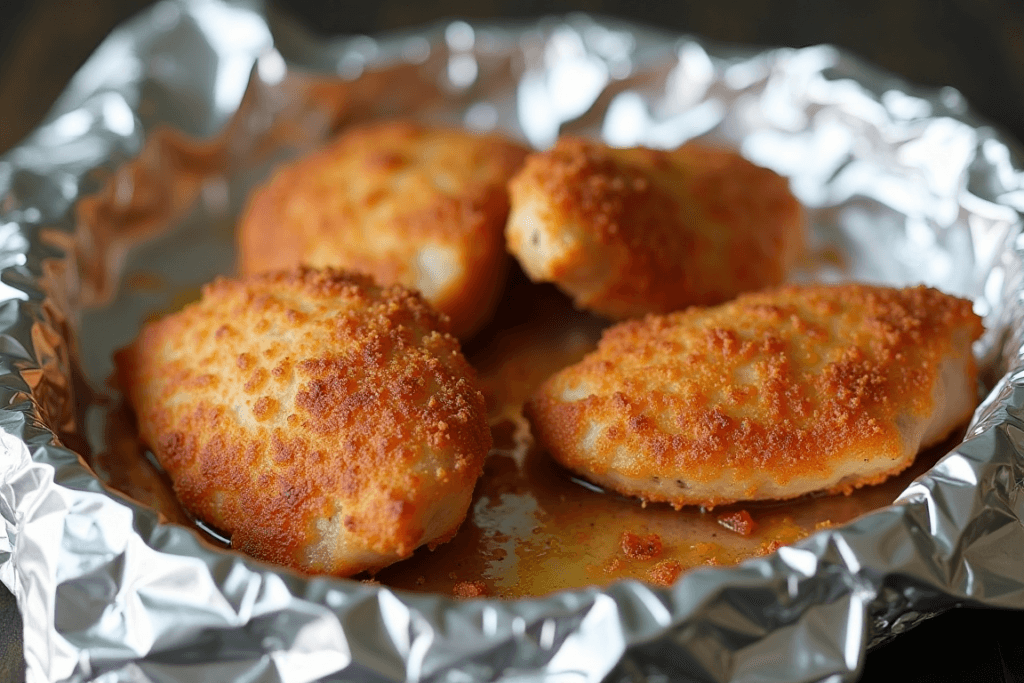Ever taken a bite of a chicken cutlet that felt like chewing on cardboard? It’s frustrating, right? Whether you’re making a crispy breaded cutlet or a simple pan-seared version, keeping it juicy and tender is a skill worth mastering. In this guide, we’re diving deep into the art of making mouthwatering chicken cutlets that are anything but dry.
Let’s be real—chicken cutlets can go from perfectly moist to disastrously dry in minutes. The secret? It’s all about the preparation, cooking technique, and timing.
“Moisture is the soul of a great chicken cutlet. Once you lose it, there’s no going back.”
Table of Contents

Why Chicken Cutlets Often Dry Out: Common Challenges
Before we tackle the solutions, let’s understand the problem. Why do chicken cutlets dry out so easily? Well, it’s all about their structure. Chicken breasts (often used for cutlets) are naturally lean, meaning they lack the fat that keeps meat juicy. Couple that with high heat or overcooking, and you’ve got a recipe for disaster.
Top Reasons for Dry Chicken Cutlets:
- Overcooking: Cooking for too long zaps all the moisture out.
- Skipping Marination: Unseasoned chicken lacks that extra layer of moisture and flavor.
- Improper Slicing: Uneven thickness leads to overcooking thin parts while thicker areas remain undercooked.
- High Heat: Excessively high heat can scorch the outside while leaving the inside dry.
Preparing Chicken Cutlets for Cooking
Now that you know what can go wrong, let’s fix it! The foundation of a juicy chicken cutlet starts before it ever hits the pan. A little prep goes a long way.
Selecting the Right Cut of Chicken
The first step is picking the right piece of chicken. Boneless, skinless chicken breasts are your go-to for cutlets, but not all chicken breasts are created equal. Look for pieces that are evenly shaped and fresh—avoid pre-frozen ones if you can.
Pro Tip: “If the chicken breast is too thick, it’ll cook unevenly. Always slice or pound it to an even thickness.”
Properly Slicing and Pounding Chicken Cutlets
Ever wondered why restaurant chicken cutlets are so perfectly tender? It’s because they take the time to pound them to the perfect thickness. Here’s how:
- Slice: Use a sharp knife to cut the chicken breast horizontally into two even pieces.
- Pound: Place the chicken between two pieces of plastic wrap or parchment paper. Use a meat mallet or rolling pin to pound it evenly to about 1/4 inch thick.
Marination: A Key to Moisture Retention
Think of marination as your secret weapon. Not only does it infuse the chicken with flavor, but it also locks in moisture. Here’s a simple, foolproof marinade:
| Ingredients | Quantities |
|---|---|
| Buttermilk or Greek yogurt | 1 cup |
| Olive oil | 2 tablespoons |
| Minced garlic | 2 cloves |
| Lemon juice | 1 tablespoon |
| Salt | 1 teaspoon |
| Black pepper | 1/2 teaspoon |
| Herbs (parsley, thyme, or rosemary) | 1 teaspoon |
Best Marinade Ingredients for Juicy Chicken
The key to a great marinade is balance. Acids like lemon juice or vinegar tenderize the meat, while fat (like olive oil) ensures moisture retention. Garlic, herbs, and spices add a punch of flavor that’ll have everyone asking for your recipe.
Let the chicken marinate for at least 30 minutes, but if you have time, 4–6 hours in the fridge is even better. Trust me, this step is a game-changer!
Cooking Methods to Retain Moisture
Now that your chicken cutlets are prepped and ready, it’s time to cook them! Choosing the right cooking method is just as important as preparation. Different methods yield different results, so let’s explore the best ways to lock in that juicy goodness.
Searing Chicken Cutlets for Maximum Juiciness
One of the simplest ways to cook chicken cutlets is to sear them in a hot skillet. This method creates a flavorful crust while keeping the inside tender and juicy. Here’s how:
- Preheat the pan: Use a heavy skillet (like cast iron) and heat it over medium-high heat for 2–3 minutes.
- Add oil: Use an oil with a high smoke point, like avocado or canola oil. Let it shimmer before adding the chicken.
- Cook in batches: Avoid overcrowding the pan; cook 2–3 cutlets at a time for even browning.
- Flip once: Let the chicken cook undisturbed for 3–4 minutes on each side, flipping only once to retain moisture.
“A golden crust doesn’t just look pretty—it seals in the juices, keeping your chicken irresistibly moist.”
Pan-Frying vs. Baking: Which Is Better?
Wondering whether to pan-fry or bake your chicken cutlets? It depends on your preferences and time constraints.
- Pan-Frying: This method gives you a crispy exterior and quick cooking time, making it ideal for breaded cutlets.
- Baking: Baking is hands-off and healthier, especially if you want to skip the oil. It works well for marinated cutlets but may lack the crispy texture.
If you’re baking, preheat the oven to 400°F (200°C) and bake the cutlets on a wire rack placed over a baking sheet. This allows air to circulate and prevents sogginess.
Using the Oven for Even Cooking
For perfectly cooked chicken every time, try the oven method. Here’s a step-by-step guide:
- Preheat the oven to 375°F (190°C).
- Place the cutlets on a baking tray lined with parchment paper.
- Brush the chicken with a little olive oil or melted butter to keep it moist.
- Bake for 20–25 minutes, flipping halfway through.
“Oven baking might take a little longer, but it’s a foolproof way to keep chicken moist without constant monitoring.”
Sous Vide Chicken Cutlets for Perfect Results
If you’re a kitchen gadget enthusiast, sous vide might just become your new best friend. This French technique involves cooking chicken in a vacuum-sealed bag submerged in water at a precise temperature. The result? Juicy, tender cutlets that are impossible to overcook.
Here’s how to do it:
- Preheat the sous vide water bath to 145°F (63°C).
- Season the chicken and place it in a vacuum-sealed bag (or a resealable bag using the water displacement method).
- Cook for 1–2 hours. The beauty of sous vide is that the chicken won’t overcook, even if left a bit longer.
- For a golden crust, quickly sear the chicken in a hot skillet after sous vide cooking.
The Role of Breading in Keeping Chicken Moist
Breading isn’t just about adding crunch—it also plays a major role in locking in moisture. The coating acts as a barrier, protecting the chicken from direct heat and helping it retain its natural juices.
Types of Breading to Prevent Dryness
There are several options when it comes to breading chicken cutlets, and each has its own benefits:
- Classic Breadcrumbs: These create a crisp, golden crust that’s a crowd-pleaser.
- Panko Breadcrumbs: Panko, or Japanese breadcrumbs, offer a lighter, crunchier texture.
- Flour and Egg Wash: For a simple, light coating, dip the chicken in flour and an egg wash.
- Herbed Crust: Mix breadcrumbs with herbs and grated Parmesan for an extra layer of flavor.
Step-by-Step Guide to Proper Breading Techniques
Breading chicken cutlets can be messy, but with the right technique, it’s easy. Follow this three-step process:
- Dry the Chicken: Pat the chicken dry with paper towels to help the coating stick.
- Set Up a Breading Station: Arrange three shallow bowls: one with flour, one with beaten eggs, and one with breadcrumbs.
- Dredge and Coat: Dip the chicken in flour, then egg, and finally breadcrumbs, pressing lightly to ensure an even coating.
Frying Breaded Chicken Cutlets Without Overcooking
When frying breaded cutlets, temperature control is key. Heat the oil to 350°F (175°C) and fry for 2–3 minutes on each side. Too low, and the breading will soak up oil. Too high, and the outside will burn before the inside cooks through.
“Think of breading as a shield—it protects your chicken while adding flavor and texture.”

Avoiding Overcooking: Time and Temperature Tips
Overcooking is the number one culprit when it comes to dry chicken cutlets. But don’t worry—mastering the right time and temperature is easier than you think. Let’s explore some foolproof methods to ensure your cutlets come out perfectly every time.
Ideal Internal Temperature for Chicken Cutlets
Chicken is considered safe to eat once its internal temperature reaches 165°F (74°C).However, carryover cooking (the process where the meat continues to cook after being removed from heat) means you can take it off the heat at around 160°F (71°C). Let it rest for a few minutes, and it’ll finish cooking on its own without drying out.
“Invest in a good meat thermometer—it’s your best friend for juicy chicken.”
How to Use a Meat Thermometer Effectively
If you’ve never used a meat thermometer before, don’t sweat it! Here’s how:
Place the thermometer into the thickest section of the chicken cutlet for an accurate temperature reading.
Avoid touching the pan or bone (if applicable), as this can give an inaccurate reading.
Wait for the thermometer to stabilize before checking the temperature.
Cooking Times for Different Methods
Not all cooking methods are created equal, and each has its own ideal timing:
Pan-Searing: 3–4 minutes per side over medium-high heat.
Baking: 20–25 minutes at 375°F (190°C).
Sous Vide: 1–2 hours at 145°F (63°C).
Frying: 2–3 minutes per side in 350°F (175°C) oil.
Resting Chicken Cutlets Before Serving
Did you know that letting your chicken cutlets rest after cooking can make all the difference? It might be tempting to dig in right away, but patience pays off!
Why Resting Improves Juiciness
When chicken is hot off the heat, its juices are still in motion. If you cut into it immediately, those juices will spill out onto your cutting board. Letting the chicken rest for 5–10 minutes allows the juices to redistribute, keeping every bite tender and moist.
Best Practices for Resting Chicken Cutlets
Here’s how to rest chicken cutlets like a pro:
Transfer the cutlets to a clean plate.
Loosely cover them with foil to retain heat.
Allow them to rest undisturbed for a minimum of 5 minutes.
“Think of resting as the grand finale—it seals the deal for a perfect chicken cutlet.”
Common Mistakes and How to Avoid Them
We’ve all been there: dry, rubbery chicken cutlets that feel more like jerky than dinner. Avoid these common mistakes to elevate your cooking game:
Overcooking: Signs and Solutions
If your chicken cutlet looks shriveled or tastes tough, it’s likely overcooked. The solution? Stick to proper timing and use a thermometer to avoid guesswork.
Skipping Marination or Seasoning
Unseasoned chicken is bland and forgettable. Always marinate or season your cutlets with salt, spices, and a touch of acid (like lemon juice) to enhance flavor and tenderness.Get inspired by What Can I Use to Coat Chicken Instead of Mayonnaise?.
Inconsistent Thickness: A Recipe for Dryness
Uneven cutlets cook unevenly, leaving you with dry, thin sections and undercooked thick parts. Always pound your chicken to a uniform thickness for consistent results.
Expert Tips for Perfect Chicken Cutlets Every Time
Looking to elevate your chicken cutlets to the next level?Try these expert-approved tips:
Adding a Sauce or Gravy for Extra Moisture
A rich sauce can transform even the simplest chicken cutlet into a gourmet dish. Think creamy mushroom sauce, tangy lemon butter, or a classic marinara for breaded cutlets.
Pairing Chicken Cutlets with Moisture-Rich Sides
Pair your cutlets with sides that complement their flavors and add moisture, like mashed potatoes, steamed veggies with butter, or a fresh cucumber salad.
Storing and Reheating Without Drying Out
Leftovers can be just as delicious as the original dish—if you store and reheat them properly. Here’s how:
Store: Wrap cutlets tightly in plastic wrap or aluminum foil and refrigerate for up to 3 days.
Reheat: Use a low oven (300°F/150°C) or a skillet over low heat with a splash of broth or water to restore moisture.
Frequently Asked Questions (FAQs)
Still have questions? Let’s clear them up!
Can You Save Dry Chicken Cutlets?
If your chicken cutlets turn out dry, don’t worry—you can still salvage them! Slice the chicken thin and serve it with a sauce or gravy to add moisture.
Is Brining Necessary for Chicken Cutlets?
While not essential, brining adds an extra layer of juiciness. A simple saltwater brine (1/4 cup salt to 4 cups water) works wonders.
How Do Restaurants Keep Chicken Moist?
Restaurants use tricks like pounding chicken evenly, marinating, and cooking to precise temperatures. Following these steps at home will give you similar results!
Conclusion: Enjoy Juicy, Flavorful Chicken Cutlets
Perfecting chicken cutlets is about preparation, technique, and timing. Follow this guide, and you’ll create juicy, flavorful dishes every time. Don’t forget to share your success stories below!
For more tips and recipes, explore How Long to Bake Thin Chicken Breast at 350 or 15 Best Chicken and Spinach Recipes for Every Occasion.
Call to Action: Share Your Chicken Cutlet Success Story
Have you mastered the art of keeping chicken cutlets juicy? Share your tips, tricks, and recipes in the comments below. Let’s inspire each other to create the perfect chicken dinner!

